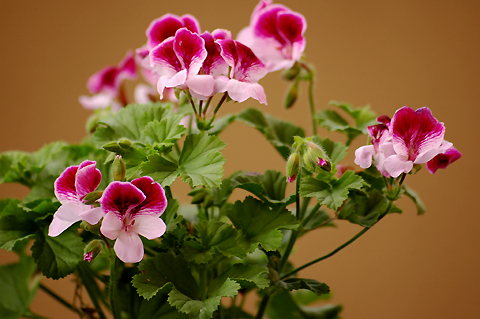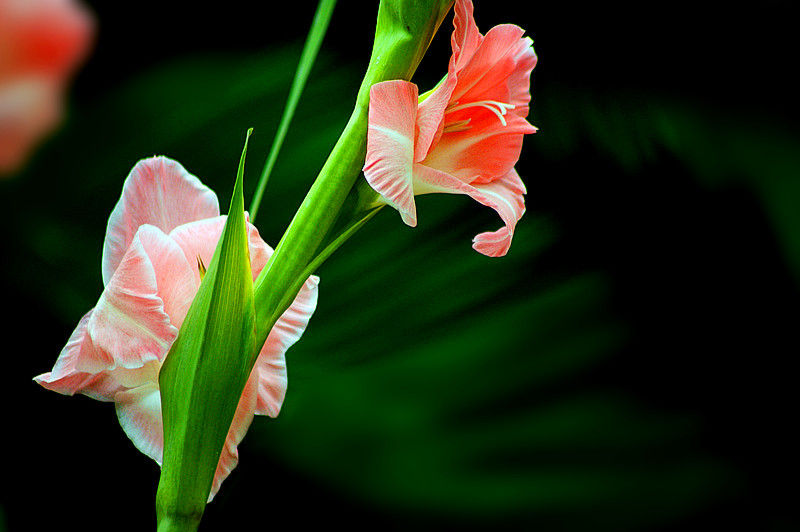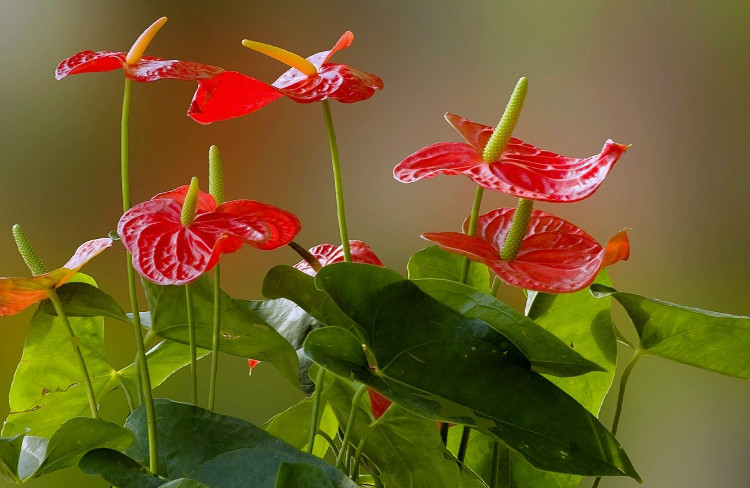Picture of how to raise a large-flowered geranium
Geranium is not kept in small series. But it's a good idea to keep a few plants indoors. Cultivated plant, closely related to geranium. Similar to geranium, except that the leaves are wrinkled and hoof lines. The flowers are large, colorful and hardy. To propagate or cultivate. See geranium. Subshrub cultivated plants, 20-90cm tall, glabrous or rarely sericeous throughout. Leaves are oval or nearly round, thick, petiole is longer, leaf margin has dense and sharp serrations, leaf surface wrinkles. Umbel axils and, with flower stems, flowers larger, colors are white, red, pink, purple and mottled, lace, etc., flowering 5-7 months. Related species of geranium. Similar to geranium, except that the leaves are wrinkled and hoof lines. The flowers are large, colorful and relatively hardy. Originated in South Africa, Cape of Good Hope area, cultivated all over the world. The species and varieties are rich, and the most widely used in China is Pelargonium (Shanghai commonly known as paraffin red). Pelargonium grandiflorum, also known as hairy leaf pelargonium, is rarely used in China, but it is the largest potted flower species in Pelargonium. The following small series of the network together to introduce you to geranium.

How about a large flower geranium?
cultivation and management
It likes cold climate, suitable growth temperature is 5℃~25℃, plants enter semi-dormant state in summer high temperature period, winter cold area can be overwintered with a little protection. Likes the light sufficient environment, bears dry, avoids the water wet, requests the cultivation substrate loose and the drainage to be good, rich in the organic matter. Geranium flowers are sown late winter to early spring and bloom throughout the summer. Sowing in late summer and keeping the temperature above 5℃ in winter can bloom in spring. The seeds germinate in the dark, and the seeds should be covered with 3~5mm thick substrate or 2~4mm thick coarse vermiculite. Sowing can use 128 hole hole tray, substrate adopts imported peat, add 10% large-grain pearlite with diameter of 3~5mm, keep medium moisture of substrate, not too wet, sprout in 5 to 10 days.
The breeding cycle is 5 to 6 weeks, divided into 4 stages. The first stage is from sowing to radicle emergence, and the second stage is from radicle emergence to cotyledon extension, germination is complete and a true leaf grows. After emergence, it is necessary to reduce the humidity of the substrate to facilitate root development. In the third stage, a true leaf appeared and began to grow, reaching the transplanting standard. The fourth stage is preparation for transplantation or storage. The germination temperature of the first stage is 21℃~24℃, which takes 3 to 5 days, and the substrate should be moderately moist. In the second stage, the temperature is 21℃~24℃, the fertilizer can be applied once a week, the N∶P∶K ratio is 15∶0∶15 and 20∶10∶20 alternately, the concentration is 50~75ppm, it takes 5 to 10 days, and the medium is wet. In the third stage, the temperature is 18℃~21℃, the fertilizer concentration is 100~150ppm, and the fertilizer is applied twice a week. It takes 14 to 21 days to basically achieve four leaves and one heart. The temperature of the fourth stage is 17℃~18℃, it takes 7 days, and the fertilizer concentration is the same as that of the third stage. After that, it can be planted in 14cm×12cm pots.
The pH value of the water should be adjusted to slightly acidic, between 5.5 and 6.5 is good, and the pH value of the matrix should be controlled between 6.2 and 6.5. Temperature During the whole seedling period, the substrate temperature should not be lower than 18℃, and the growth and development of seedlings should be hindered if the temperature is too low.
Origin Information
Originated in South Africa, Cape of Good Hope area, cultivated all over the world. The species and varieties are rich, and the most widely used in China is Pelargonium (Shanghai commonly known as paraffin red). Pelargonium grandiflorum, also known as hairy leaf pelargonium, is rarely used in China, but it is the largest potted flower species in Pelargonium.
Flowering in April. Geranium is a perennial herbaceous flower belonging to the genus Pelargonium of Geraniaceae. Variety of colors, pink, reddish, white, brown, purple, light purple, pure white, pink, scarlet, purple, orange, compound color, etc., blooming, a large flower ball composed of more than ten flowers can last more than half a month, colorful, widely used in gardens. Tissue culture of other Pelargonium species has been reported, but tissue culture of Pelargonium grandiflorum has not been reported.
Geranium large flower Geranium large flower Geranium varieties and flower language complete
Geranium is a relative plant of the Yangtze River in the north. It is a relative species of geraniaceae and geranium. Its entire plant is glabrous or rarely sericeous. The leaves of large flower geranium are oval or nearly round, thick in quality, long in petiole, large in flower, and more in flower color. Because of the large flower geranium flowers, colorful, but also relatively cold, very popular with people's favorite. Today, let's take a look at the introduction of geranium varieties and flower language with Xiaobian. Pelargonium grandiflorum is a perennial herb, produced up to 30-40 cm tall, with erect stems and branches. Its base lignified, spreading villous. The leaves of the big flower Indian orchid are alternate, the stipules are dry and membranous, triangular and broadly ovate, and the leaves are 8-10 mm long and 6-8 mm wide. Its lower petiole is 8-13 cm long, upper petiole is shorter, pilose. The silver bracelet of the large flower geranium is round kidney shape, the base is heart shape or truncated shape. Its corolla is pink, reddish, crimson or white. The flowers bloom in July and August each year. Geranium species Geranium species Geranium is Geranium family, Pelargonium genus two categories, and different regions of latitude and longitude growth of geranium is not the same, which also makes its varieties are different. The large flower geranium called hairy leaf geranium is relatively rare in China, but this plant is the largest flower in geranium. Because of the large flower geranium color comparison, its color has deep red, brown, lavender, pink white, scarlet, purple, compound color and white. Geranium flower language geranium flower language is accidental encounter, happiness on your side. And different colors of geranium flower language is also different, and red geranium flower language is you lingering in my mind. And the pink geranium flower is happy to be with you. Geranium is the pride of African people, in Europe is also very popular, and in Hungary will also be colorful large flower geranium as the national flower. The value of large flower geranium large flower geranium can be used to condition the skin, has a strong affinity, can be combined with organic fat to make a lipid products. If you use the facial cleanser made of geranium every day to clean your face, it can be effectively absorbed by the skin. Geranium has the effect of shrinking pores and promoting blood circulation. After use, it will make pale skin ruddy and vibrant, making skin shiny and delicate. It is the most natural beauty medicine. It is also good for loose, clogged pores and oily skin. Summary: The above is a small series to introduce you to the introduction of large flower geranium varieties and flower language, after reading the introduction of small series, I believe everyone knows better. The adaptability of large flower geranium is strong, the color is bright, the florescence is long, it is very suitable for indoor display and flower bed layout. How do large flower geraniums vernalize? Vernalization of Pelargonium grandiflorum
Before in a geranium forum to see a flower friend asked geranium vernalization knowledge, there are flower friends big flower geranium when vernalization? What is vernalization? How to deal with the vernalization of large flower geranium? With these questions, the following small series will combine the flower friend's maintenance experience to tell you about the knowledge of the big flower geranium vernalization.
1. What is vernalization?
Vernalization-Some flowers need low temperature conditions to promote flower bud formation and flower organ development, this process is called vernalization stage, and this low temperature stimulation and treatment process that makes flowers pass through vernalization stage is called vernalization.
II. The role of vernalization
Vernalization can make angels flowery, but for most large flowers already in China, vernalization is necessary, otherwise they may not bloom.
III. Specific operation of vernalization
From November to the end of December, flowers are kept indoors in unheated buildings, without sun during vernalization. If the corridor temperature is not low, it can be placed in the closed north balcony.
Theoretically, the temperature is controlled at 5℃-10℃. Practical conclusion: 5-8℃ is the best.
Generally speaking, if the temperature exceeds 10℃, the vernalization time needs to be extended; if it exceeds 15℃, the vernalization cannot be completed.
After vernalization, take the flowers back and put them indoors to warm up and bask in the sun. Buds appear after the middle of January, and flowers begin to bloom around the Spring Festival. Premise: There is heating. Beijing area according to the above practice, big flower geranium has been blooming from the Spring Festival, you can see July oh, to the end of the dog days, about 5 months of flowering. Of course, late-flowering varieties may bloom around March.
In addition, upright geranium and hanging geranium, which can bloom without vernalization, should be moved into the house for the night around the frost season.
Summary: The above is about geranium vernalization knowledge introduction, hope to plant geranium flower friends helpful.
- Prev

The culture method of how to raise sword orchid
Gladiolus, alias: ten brocade, sword orchid, calamus orchid, water chestnut lotus, Latin name: VaniotHoutt, Iridaceae, Gladiolus perennial herbs. The bulb is oblate and spherical, and its original species comes from the Cape of good Hope in South Africa. It has been crossed many times, and its cultivated varieties are widely distributed all over the world. The flower stem is higher than the leaf.
- Next

What if the leaves of Anthurium andraeanum are yellow and withered?
Anthurium andraeanum is fascinating with its green leaves, bright scarlet bracts and inflorescences inlaid with gold and jade. Its warm, enthusiastic, enthusiastic and enterprising artistic conception makes people happy. In recent years, with the continuous improvement of the sales form of Anthurium andraeanum potted flowers, more and more flower manufacturers want to enter this field.
Related
- Fuxing push coffee new agricultural production and marketing class: lack of small-scale processing plants
- Jujube rice field leisure farm deep ploughing Yilan for five years to create a space for organic food and play
- Nongyu Farm-A trial of organic papaya for brave women with advanced technology
- Four points for attention in the prevention and control of diseases and insect pests of edible fungi
- How to add nutrient solution to Edible Fungi
- Is there any good way to control edible fungus mites?
- Open Inoculation Technology of Edible Fungi
- Is there any clever way to use fertilizer for edible fungus in winter?
- What agents are used to kill the pathogens of edible fungi in the mushroom shed?
- Rapid drying of Edible Fungi

